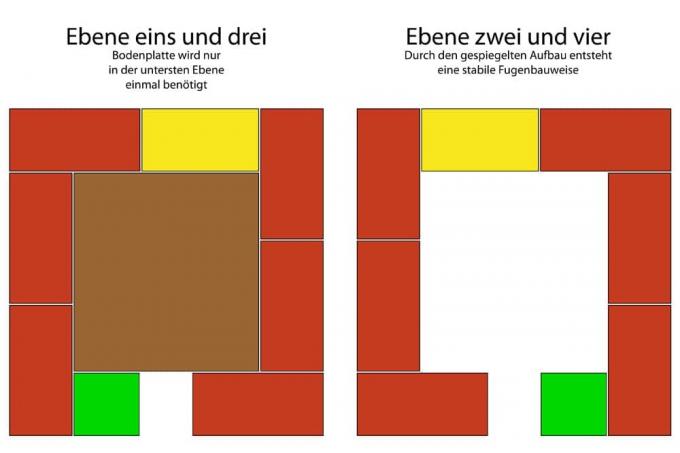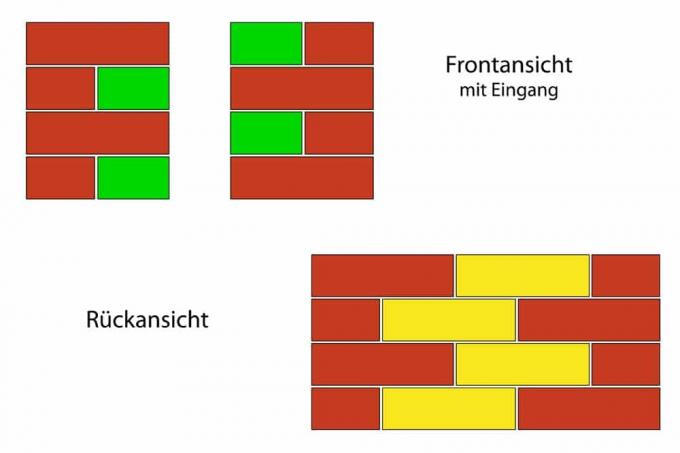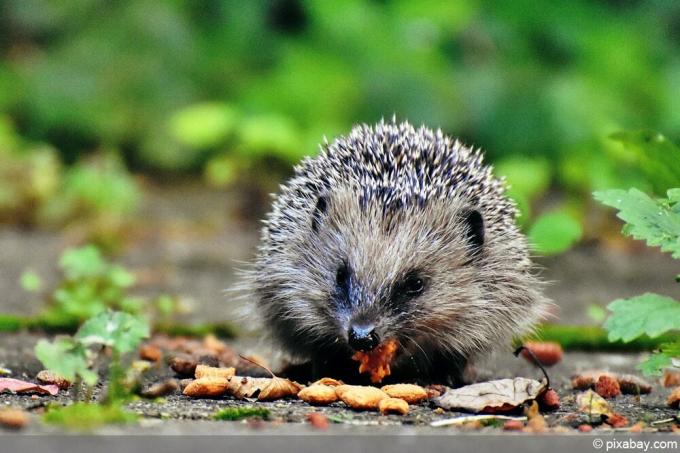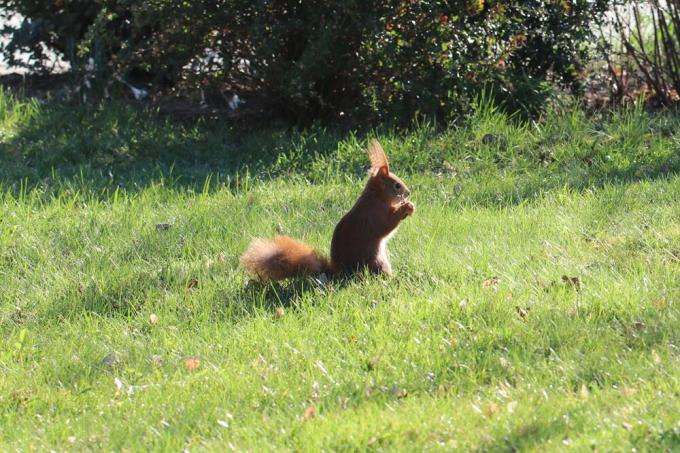

Table of contents
- Hedgehog house no. 1: The invisible brick building
- Igelhaus 2: The pretty, comfortable wooden bungalow
- The location for the hedgehog house
- With or without a floor?
- The "maintenance" of the hedgehog house
- Hedgehogs are pretty useful in the garden
With the following instructions it will be a pleasure to build and set up a hedgehog house yourself. You can choose whether it will be a very entertaining pleasure or whether a "hedgehog villa" will be created that only seasoned do-it-yourselfers can manage perfectly:
Hedgehog house no. 1: The invisible brick building
If you need a hedgehog house in the garden right now, but you are not one of the eager do-it-yourselfers and you are not plan to become a keen do-it-yourselfer one day: Anyone can build this hedgehog house, it just becomes easy piled up. This has the additional advantage that the construction time is reduced to a minimum.

You don't need a lot of material either:
- 30 bricks, current German standard format (NF), 24 long, 11.5 wide, 7.1 high
- Lumber plank or concrete paving slab for the roof, larger than the base slab and not much larger than the overall floor plan
- possibly Base plate 34 x 36.5 cm
- cutter
- Odorless roofing felt or foil
- straw, dry leaves
This is how the “Hedgehog house is built quickly and easily”:
- Cut out a piece of cardboard measuring 34 x 36.5 cm as a placeholder for the interior
- Place placeholders on the floor at the desired location
- Stack the bricks around the placeholder
- Lay out 7.1 stones in 4 layers per layer
- The stones of the 2. layer shifted to layer 1
- And the stones of the 4th Layer shifted to layer 3

- Four of the normal format bricks (24 x 11.5 x 7.1) must be shortened by 2.5 cm
- They are inserted in the rear area at the color-coded positions
- Necessary so that the entrance is only 10 cm wide (good for hedgehogs, bad for cats and birds of prey)
- 4 layers in height - base plate result in approx. 30 cm (including Mörgel), a sufficient height for hedgehogs
- A board made of wood or a paving slab made of concrete are suitable as a "quick roof".
- The pavement slab does not go over the entire width of the stone, which is irrelevant because of the casing of the hedgehog house presented below
- The wooden board can be cut to fit
- But a 60×60 cm slab will also do, a little overhang at the entrance is more of a positive
- However, wood must be impregnated with substances whose smell does not bother hedgehogs (see tip).
- When the hedgehog house is up, the interior can be comfortably furnished
- Straw and/or dry leaves are suitable for this
- Which should simply be scattered and not arranged until they have taken on the scent of man
- If necessary, replace the placeholder cardboard with a floor board, see below

When the actual house or "inner house" is up, the highlight of this hedgehog house comes: It is packed so nicely all around that the Hedgehog sleeps heat and noise insulated and the hedgehog house from the outside like a small green hill and natural part of the garden works. For this you need soil, grass and moss slabs, brushwood, possibly. Garden netting or rabbit wire for attachment and a little artistic skill. If the artificial mound looks a bit wild at first, don't worry - as the grass and moss grow, the individual pieces will fall into place.
Igelhaus 2: The pretty, comfortable wooden bungalow
This wooden house is the variant for all do-it-yourselfers who like to work with their hands, but also like to finish at some point.
Material list:
- 5 or 6 approx. 30 x 30 cm wooden boards for walls, roof and ev. soil, a separate paragraph follows below
- The board for the roof can be a little bigger
- Screws or nails to assemble
- jigsaw
- Odorless roofing felt or foil
- Environmentally friendly, odorless water protection glaze
- straw, dry leaves
Construction of the hedgehog house:
- Make all boards waterproof with environmentally friendly glaze
- Allow the wood to dry thoroughly in a warm interior room
- In one of the wall boards approx. Saw a 10 x 10 cm opening
- This entrance lets hedgehogs through, but not cats
- walls and possibly Assemble the base with screws or nails
- Put on and fasten the roof
- The roof can protrude a little to the front, which protects against penetrating moisture
- A piece of roofing felt or a foil of a suitable color can be nailed on to protect against moisture from above
- Pad the floor of the finished hedgehog house with straw or dry leaves
When the hedgehog house is on the prepared spot, it can be covered again, e.g. B. with the excavation (see soil). You can also use bark mulch, straw, and twigs made from fine branches for cover; The purpose is additional protection against the cold and to protect the hedgehog from curious pets. A lot of leaves on the hedgehog house are also good for autumn and winter, so the artificial building finally becomes a near-natural nesting and wintering place.

This hedgehog house takes a little more time than the brick layer construction, but this is kept within limits. Ambitious do-it-yourselfers will of course find completely different instructions on the Internet, including mortised masterpieces with complicated inner workings. It doesn't matter to the hedgehog which design to move into, it hibernates in the brick building and also in the Wooden house, even if you have the Burj Khalifa or the Allianz Arena in wood at the top recreate But he only cares as long as the construction in the lower area corresponds exactly to the specifications and in the doesn't look too unnatural in the upper part (nobody will tell you where the limit is for hedgehogs can). A completely different argument against "magnificent buildings" could be that admirers of architecture would have to remain as still as a mouse in order not to wake the hedgehog from hibernation.
Tip:
Enthusiastic do-it-yourselfers often want to opt for the wooden bungalow immediately because stacking bricks does not satisfy their ambition. But be careful: the wooden bungalow must be made water-repellent. And the great boat paint from the basement, with which you have already had good experiences, is not necessarily suitable. Much of what is offered in the hardware store under "wood protection for outside" should stink to hedgehog noses, so that the hedgehog house would remain empty with such a coat of paint (also products with environmental awards). If you work with wood, you should contact the nearest hedgehog station or one Nature conservation organization inquire which of the paints currently on the market is already was tested "hedgehog-suitable". Recommendations in building instructions are often not up-to-date, since changes are constantly being made in this product area.
The location for the hedgehog house
The children would like to see if the hedgehog is doing well every day - but since they shouldn't be doing that under any circumstances, they shouldn't the hedgehog house is best placed in the last corner in the garden (where it is no longer the focus of attention as quickly as possible).
Otherwise, it is still important not to choose a sink in which the water collects. If present, rather the opposite: a small hill, from which even the strongest ruler quickly drains away without "taking the hedgehog and his house with him". And the place shouldn't be on the weather side (resp. with the slip towards the weather side) where any rain and wind will be uncomfortable.
A good spot offers some rain protection from above, e.g. B. under (even in winter still dense) trees, bushes or at the edge of a hedge. It is also quite well hidden under the trees and bushes and ideally offers the hedgehog enough material to make the hedgehog house even more cuddly.
With or without a floor?
Construction instructions for hedgehog houses often provide for a floor, while hedgehogs in the wild live in caves or have to hibernate in holes in the ground without a floor construction (which, however, is well insulated from hedgehogs with natural materials become). In the instructions of the German Nature Conservation Union, it is recommended to put two pieces of batten under the house on the sides so that "the hedgehog doesn't get wet feet". The hedgehog still lies on the floor, which is padded with leaves and straw, except that the leaves and straw are ventilated from the side. Which, in turn, would only be important if the hedgehog house were in danger of being flooded - but a hedgehog house should under no circumstances be built in such a location.
The manufacturer of a purchasable Hedgehog Ritz (a kind of ceramic cave replica) recommends placing it in a quiet spot in the garden and letting the top layer of soil approx. lift 5 cm. Until a dry surface without grass or Layer of leaves is created, in which sand or fine gravel are now scattered as an insulating layer. So that no waterlogging forms under the Igel-Ritz, this underlayer should now be covered with straw, hay, Wood wool or something similar should be covered as a padding layer, the hedgehog should have additional nesting material search yourself. Which of course assumes that he can find enough loose material in the area. In a rather tidy garden or to hibernate young hedgehogs that have been found, the hedgehog Ritz should therefore be additionally padded.
The dispute is open, depending on the existing soil and environmental conditions, choose a variant and you may want to ask your local hedgehog protection agency what the best soil solution is for the local climate holds. Please do not use Styrofoam as a base plate, which is well insulated, but is also regularly scratched and nibbled on by hedgehogs, which is not good for the hedgehog's stomach at all.
Eventually, a hedgehog in hibernation distress will accept many shelters; but probably the plain natural shelter rather than the grand palace. And a floor made of a natural material always makes sense if the intended location could get wet.
The "maintenance" of the hedgehog house

Once the hedgehog house has been occupied, the best care for a healthy hedgehog is to simply leave the hedgehog alone. When he wakes up in the spring and has moved out, the hedgehog house gets its spring cleaning: Clean it up the hedgehog house is best in May, then the hibernation is over, but the whelping time has not yet come began.
For cleaning, please only use hot water without detergents, then let the house dry out a little and then fill it with new nesting material. Your new garden dweller may continue to use the hedgehog house to fill it with offspring. Then not only one hedgehog will work for you in the future, but a whole family of hedgehogs:
Hedgehogs are pretty useful in the garden
If the kids have been bugging you for a while, but you're not quite sure if you want to really want to do "fun with the hedgehog", here are a few arguments apart from all nature conservation and Environmental Considerations:
- Hedgehogs are a great cleaning crew that first eat the things that disturb the garden first:
- Dead insects, worms and mice, even if they no longer smell very appetizing
- Beetles that would like to go indoors, larvae that would like to go into the kitchen
- Earwigs, centipedes and millipedes, bugs and vine weevils
- Hedgehogs particularly like to eat the favorite enemy of many gardeners: snails, preferably fat slugs
- But also all other insects, every sprawling population is quickly brought back to normal by a hedgehog
- Since there are no vegetarians among the hedgehogs, the fruits and vegetables in the garden are safe from them
If a hedgehog house is accepted and there are perhaps offspring, you no longer need to worry too much about "biological plant protection". Incidentally, hedgehogs prefer to settle in gardens in which there is a colorful mixture of groundcover instead of cleanly raked areas instead of accurately pruned shrubs, there are free-growing bird protection shrubs, instead of perfect order, a little "chaotic". Nature". If there are wild corners with piles of leaves, undergrowth, stacks of old wood, you don't need to build them a hedgehog house either, the hedgehog can do it alone in the natural garden.
Tip:
When hedgehogs wander around for days in the frost instead of forgetting the world for a while in the hedgehog house they probably did not manage to maintain their "hibernation weight" of about 500 g over the course of the season to eat. Such young hedgehogs should be taken to the nearest hedgehog station to be nursed back to health. An older hedgehog can then always move into the hedgehog house.
 garden editorial
garden editorial I write about everything that interests me in my garden.
Learn more about beneficial insects

What does hedgehog droppings look like? | Recognize hedgehog droppings
Hedgehogs are not only very cute, but also useful animals. a. devour the unpopular slugs in the garden. They feel particularly comfortable in natural gardens. Their legacies, which can even be hazardous to health, are less pleasant.

What does raccoon droppings look like? How to recognize him
Raccoons are purely outwardly, quite cute contemporaries. However, this does not hide the fact that these are wild animals that can cause great damage in the garden and on the house. This masked intruder can pose a danger to residents and pets.

Recognizing squirrel droppings: typical appearance with picture
Gardens provide an oasis for many wild animals to forage there. The animal visitors leave clearly visible traces in the form of droppings. If you take a closer look at the pieces of excrement, you can see which animal was the cause based on certain clues.

Recognizing fox droppings: 5 characteristics with a picture of the fox droppings
If animal droppings are found in the garden, it is annoying in any case. However, there can also be a danger with fox droppings in particular. But how can fox droppings be recognized and what should be considered when removing it?

drive away wild bees | What to do against wild bees in the garden?
If you want to drive away and get rid of wild bees, you should use natural and gentle means. Because the insects are useful in the garden and generally important for the environment. In addition, they are rarely threatening. We reveal how the fight works.

List: these ant species exist in Germany - ants
Ants can be found everywhere, whether in the forest, on a roadside, in the garden or even on the terrace and in the house if there is something interesting for the animals. But not all ants are the same, there are over 13,000 species of ants worldwide, 200 of them in Europe alone.



